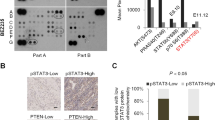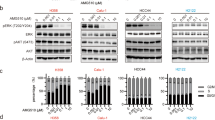Abstract
We recently reported that internal deletion of PTEN tumor suppressor gene in OPM2 and Δ47 myeloma lines led to high Akt activation. Re-expression of PTEN induced strong apoptosis and growth inhibition. To understand the biologic importance of the phosphatidylinositol 3 kinase (PI3K)/Akt activation affected by PTEN deletion, we analysed apoptosis and growth inhibition by applying PI3K inhibitors to myeloma lines and by expressing Akt constructs. The PI3K inhibitors preferentially suppressed PTEN-null myeloma growth to those expressing PTEN, indicating that PI3K activation is more critical for growth and survival of those lines with PTEN mutations than others expressing a functional PTEN gene. Since PTEN-null myeloma lines exhibited much stronger Akt activation than PTEN-expressing cells in response to insulin-like growth factor I stimulation, we determined whether Akt could be responsible for PI3K-mediated cell survival and growth of PTEN-null myeloma lines. Expression of an active Akt, but not its kinase dead mutant, reversed wortmannin- and dexamethasone-induced apoptosis and growth inhibition in PTEN-null myeloma lines, suggesting that Akt lies downstream of PI3K for PTEN-null myeloma survival and dexamethasone resistance. In summary, we have provided evidence that PTEN-null myeloma cells are stringently dependent on the PI3K/Akt activation for cell survival. These results may provide a basis to treat myeloma patients with PI3K and Akt inhibitors.
This is a preview of subscription content, access via your institution
Access options
Subscribe to this journal
Receive 50 print issues and online access
$259.00 per year
only $5.18 per issue
Buy this article
- Purchase on Springer Link
- Instant access to full article PDF
Prices may be subject to local taxes which are calculated during checkout





Similar content being viewed by others
References
Alessi DR, Andjelkovic M, Caudwell B, Cron P, Morrice N, Cohen P and Hemmings BA . (1996). EMBO J., 15, 6541–6551.
Arcaro A and Wymann MP . (1993). Biochem. J., 296, 297–301.
Cantley LC and Neel BG . (1999). Proc. Natl. Acad. Sci. USA, 96, 4240–4245.
Choi Y, Zhang J, Murga C, Yu H, Koller E, Monia BP, Gutkind SJ and Li W . (2002). Oncogene, 21, 5289–5300.
Desikan KR, Dhodapkar MV, Munshi NC and Barlogie B . (1999). Curr. Opin. Hematol., 6, 216–221.
Favata MF, Horiuchi KY, Manos EJ, Daulerio AJ, Stradley DA, Feeser WS, Van Dyk DE, Pitts WJ, Earl RA, Hobbs F, Copeland RA, Magolda RL, Scherle PA and Trzaskos JM . (1998). J. Biol. Chem., 273, 18623–18632.
Feinman R, Sawyer J, Hardin J and Tricot G . (1997). Hematol. Oncol. Clin. N. Am., 11, 1–25.
Gado K, Silva S, Paloczi K, Domjan G and Falus A . (2001). Haematologica, 86, 227–236.
Ge NL and Rudikoff S . (2000). Oncogene, 19, 4091–4095.
Hallek M, Leif Bergsagel P and Anderson KC . (1998). Blood, 91, 3–21.
Hideshima T, Nakamura N, Chauhan D and Anderson KC . (2001). Oncogene, 20, 5991–6000.
Hsu J, Shi Y, Krajewski S, Renner S, Fisher M, Reed JC, Franke TF and Lichtenstein A . (2001). Blood, 98, 2853–2855.
Hsu JH, Shi Y, Hu L, Fisher M, Franke TF and Lichtenstein A . (2002). Oncogene, 21, 1391–1400.
Hyun T, Yam A, Pece S, Xie X, Zhang J, Miki T, Gutkind JS and Li W . (2000). Blood, 96, 3560–3568.
Jelinek DF . (1999). Hematol. Oncol. Clin. N. Am., 13, 1145–1157.
Jelinek DF, Witzig TE and Arendt BK . (1997). J. Immunol., 159, 487–496.
Kandel ES and Hay N . (1999). Exp. Cell Res., 253, 210–229.
Kyle RA . (2001). Oncologist, 6, 119–124.
Li W, Hyun T, Heller M, Yam A, Flechner L, Pierce JH and Rudikoff S . (2000). Cancer Res., 60, 3909–3915.
Li W, Jiang Y-X, Zhang J, Soon L, Flechner L, Kapoor V, Pierce JH and Wang L-H . (1998). Mol. Cell. Biol., 18, 5888–5898.
Li W, Zhang J, Flechner L, Hyun T, Yam A, Franke T and Pierce J . (1999). Oncogene, 18, 6564–6572.
Maehama T and Dixon JE . (1998). J. Biol. Chem., 273, 13375–13378.
Murga C, Laguinge L, Wetzker R, Cuadrado A and Gutkind JS . (1998). J. Biol. Chem., 273, 19080–19085.
Niesvizky R, Siegel D and Michaeli J . (1993). Blood Rev., 7, 24–33.
Nishimoto N, Shima Y, Yoshizaki K and Kishimoto T . (1997). Hematol. Oncol. Clin. N. Am., 11, 159–172.
Ogawa M, Nishiura T, Oritani K, Yoshida H, Yoshimura M, Okajima Y, Ishikawa J, Hashimoto K, Matsumura I, Tomiyama Y and Matsuzawa Y . (2000). Cancer Res., 60, 4262–4269.
Scheid MP and Woodgett JR . (2001). Nat. Rev. Mol. Cell Biol., 2, 760–768.
Shi Y, Gera J, Hu L, Hsu JH, Bookstein R, Li W and Lichtenstein A . (2002a). Cancer Res., 62, 5027–5034.
Shi Y, Hsu JH, Hu L, Gera J and Lichtenstein A . (2002b). J. Biol. Chem., 277, 15712–15720.
Simpson L and Parsons R . (2001). Exp. Cell Res., 264, 29–41.
Toker A and Cantley LC . (1997). Nature, 387, 673–676.
Tu Y, Gardner A and Lichtenstein A . (2000). Cancer Res., 60, 6763–6770.
Vanhaesebroeck and Alessi DR . (2000). Biochem. J., 346, 561–576.
Vazquez F and Sellers WR . (2000). Biochim. Biophys. Acta, 1470, M21–M35.
Vivanco I and Sawyers CL . (2002). Nat. Rev. Cancer, 2, 489–501.
Vlahos CJ, Matter WF, Hui KY and Brown RF . (1994). J. Biol. Chem., 269, 5241–5248.
Acknowledgements
This work was supported by the Multiple Myeloma Research Foundation. We thank JS Gutkind for Myr-Akt construct, Ying Wang, Jun Han, and Hong Yu for excellent technical assistance. We are also grateful for the critical reading of manuscript by Kenneth Anderson.
Author information
Authors and Affiliations
Corresponding author
Rights and permissions
About this article
Cite this article
Zhang, J., Choi, Y., Mavromatis, B. et al. Preferential killing of PTEN-null myelomas by PI3K inhibitors through Akt pathway. Oncogene 22, 6289–6295 (2003). https://doi.org/10.1038/sj.onc.1206718
Received:
Revised:
Accepted:
Published:
Issue Date:
DOI: https://doi.org/10.1038/sj.onc.1206718
Keywords
This article is cited by
-
The Lipid Side of Bone Marrow Adipocytes: How Tumor Cells Adapt and Survive in Bone
Current Osteoporosis Reports (2018)
-
Identification of a promising PI3K inhibitor for the treatment of multiple myeloma through the structural optimization
Journal of Hematology & Oncology (2014)
-
The PI3K inhibitor GDC-0941 combines with existing clinical regimens for superior activity in multiple myeloma
Oncogene (2014)
-
Loss of PTEN function may account for reduced proliferation pathway sensitivity to LY294002 in human prostate and bladder cancer cells
Journal of Cancer Research and Clinical Oncology (2009)
-
Atiprimod blocks STAT3 phosphorylation and induces apoptosis in multiple myeloma cells
British Journal of Cancer (2005)



